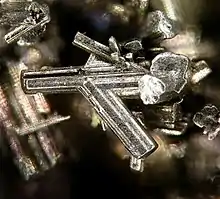Argentopyrite
Argentopyrite is a moderately rare sulfide mineral with formula AgFe2S3. It is one of the natural compounds of the M Fe2S3 type, with M being caesium in very rare pautovite, copper in relatively common cubanite, potassium in rare rasvumite and thallium in rare picotpaulite. The type locality is Jáchymov in Czech Republic. Chemically similar mineral include sternbergite (dimorphous with argentopyrite), lenaite, AgFeS2, and argentopentlandite, Ag(Fe,Ni)8S8.[1]
| Argentopyrite | |
|---|---|
 Argentopyrite (from Schneeberg, Erzgebirge, Saxony, Germany) | |
| General | |
| Category | Sulfide mineral |
| Formula (repeating unit) | AgFe2S3 |
| Strunz classification | 2.CB.65 |
| Crystal system | Monoclinic |
| Crystal class | Prismatic (2/m) (same H-M symbol) |
| Space group | P1121/n |
| Identification | |
| Color | Bronze-brown or gray-white; iridescent (many colors) |
| Crystal habit | Tabular prisms, pseudohexagonal or pseudo-orthorhombic, possibly pyramidally-terminated |
| Fracture | Uneven |
| Tenacity | Brittle |
| Mohs scale hardness | 3.5-4 |
| Luster | Metallic |
| Streak | Grey |
| Diaphaneity | Opaque |
| Density | 4.25-4.27 |
| References | [1][2][3] |
Crystal structure
Although previously assumed orthorhombic,[4] argentopyrite was later shown to be monoclinic, with structural relationship to cubanite. The most important feature of the argentopyrite structure are:[5]
- hexagonal close-packing of sulfur atoms
- presence of AgS4 and FeS4 tetrahedra in sheets displaying corner-sharing
- presence of a cluster of four FeS4 tetrahedra that share edges
- presence of two iron sites, instead of one as in related species
- ordered-disordered ferrous-ferric nature of the mineral
References
- "Argentopyrite - Argentopyrite: Argentopyrite mineral information and data". Retrieved 2016-03-07.
- "Argentopyrite" (PDF). Retrieved 2016-03-07.
- Mineralienatlas
- Murdoch, J., and Berry, L.G., 1954. X-ray measurements on argentopyrite. American Mineralogist 39, 475-485
- Yang, H., Pinch, W.W., and Downs, R.T., Crystal structure of argentopyrite, AgFe2S3, and its relationship with cubanite. American Mineralogist 94, 1727-1730
This article is issued from Wikipedia. The text is licensed under Creative Commons - Attribution - Sharealike. Additional terms may apply for the media files.
